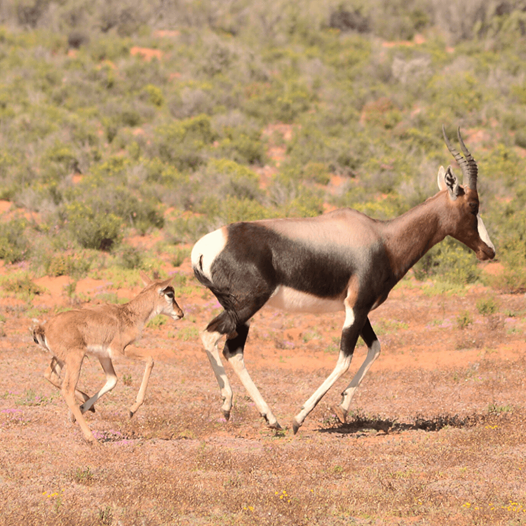Kagga Kamma announced the birth of their first Bonebok calf on January 19. This is the first calf to be born here in ‘recent years’ said the reserve.

The bontebok calf is a sliver of hope for the species. Image: Kagga Kamma Nature Reserve
‘Kagga Kamma is elated to announce the welcoming of our first Bontebok calf in recent years! While our Rangers have not been able to get close enough to identify the gender of this spritely addition to the herd, it warms our hearts to know what an accomplishment it is to drive the repopulation of this endangered species,’ said the Facebook post.
This is a major win for the blesbok subspecies, as they have been balancing between being critically endangered and extinct for decades.
These animals are endemic to the Western Cape and were hunted so horrifically in the 1930s that only 17 individuals remained. Today they are listed as Vulnerable on the IUCN’s Red List, a step above endangered.
Taking it back to colonial days, one farmer took mercy on these animals that were being savagely killed.
‘The Dutch settlers saw the bontebok, a beautiful sleek coated, hoofed mammals with a white rump patch and gorgeous purple highlights, as competition for farmland and mercilessly shot huge numbers of them without mercy or restraint,’ said Kagga Kamma in a blog post.
‘The extinction of the bontebok loomed dangerously on the horizon, but unlike many other extinct mammal species, the bontebok had a seemingly serious biological flaw that would ultimately save its life – it could not jump! Unlike the unbelievable athleticism of the springbok, who can jump 13 feet into the air, the bontebok cannot even clear a very basic livestock fence,’ the post continued.
A farmer managed to save a herd of 17 bontebok from the killing, by means of a livestock fence which they were unable to jump over.
Bredasdorp farmers began breeding bontebok which resulted in the creation of Bontebok National Park (BNP), established in 1931 in Bredasdorp.
The park was then established just outside of Swellendam, where it remains today.
In recent history, conservationists have worked hard to drive population numbers up. Bonteboks were taken from BNP to a farm in Grahamstown called Thornkloof to establish a new population.
‘Bontebok from the original park were translocated to the new park along with a few from the Thornkloof farm. A few of the Thornkloof farm bontebok were sent to the De Hoop Nature Reserve and the then Cape Point Nature reserve (Table Mountain National Park),’ said CapeNature.
Today the bontebok, which are found in small and isolated populations, are threatened by low genetic diversity, population fragmentation, habitat fragmentation and hybridisation says CapeNature.
‘Most of the vegetation types that constituted the bontebok’s original habitat are classified as Vulnerable, Endangered or Critically Endangered, resulting in 70% of the habitat being threatened. Only <10% of the original extent of renosterveld within the natural distribution range of the bontebok still remains,’ said CapeNature.
The bontebok future is hopeful based on the collaborative efforts of CapeNature, SANParks, the Department of Environmental Affairs and South African National Biodiversity Institute, among other conservationists.
On the flip side of this, one quick Google search for ‘bontebok hunting’ will deliver various results of where one can trophy hunt this fragile subspecies.


















